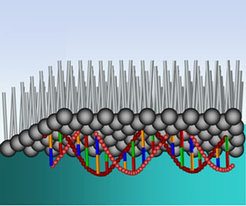Lipid-DNA Interactions

Self-assembling and ordering of DNA molecules at planar oppositely charged surfaces is of particular interest for the elaboration of biomaterials, functional nanostructures, DNA-chips, biosensors and nanodevices. Another important field requiring a deeper understanding of the mechanisms of DNA interaction with cationic lipids is medical gene therapy, which seems to be the most innovative method in the treatment of genetic and serious acquired diseases. Lipid/DNA complexes mimic the ability of natural viruses to transfect genetic material to the cell core but in contrast to the viral systems they do not have immunogenic potential or restrictions with regard to the size of the delivered gene fragments. However, cationic lipids and also other non-viral vectors like polymers and peptides suffer from low transfection efficacy and pronounced toxicity. Further success will only be achieved by designing new compounds followed by in vitro tests of their transfection activity and cytotoxicity.
New cationic lipids have been and will be synthesized by our cooperation partner (Prof. B. Dobner, Institute of Pharmacy, Martin Luther University Halle), which have primary, secondary and/or tertiary amines in their head groups. Such head groups can be protonated - charged or deprotonated - uncharged at more acidic or more alkaline pH, correspondingly. Our aim is to contribute to the understanding of the interactions of DNA with such specially designed lipids. The lipids will be organized either as Langmuir monolayers at the air/water interface or as vesicles in aqueous dispersions. The important question to be investigated is the perspective to use the novel compounds as pH-sensitive delivery vectors, that means to study in detail the effect of subphase pH on the physical-chemical properties of the cationic lipids, on DNA adsorption and on the structure of the DNA/lipid complexes. The figure below shows our model how the DNA coupling to a lipid monolayer leads to an alignment of the adsorbed DNA strands. The distance between aligned DNA strands does not change much if the lipid layer is condensed but decreases considerably if a liquid lipid layer is compressed.
